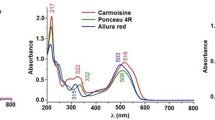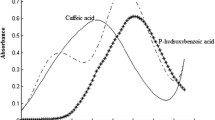Abstract
Calibration is a fundamental step in instrumental quantitative methods that produce an analytical signal proportional to the concentration of the analyte in the sample. Multi-wavelength calibration (MWC), a novel calibration strategy, has been proposed as a simple method for the determination of analytes in samples with complex matrices. It has minimal matrix effects and straightforward sample preparation. The objective of this work was to apply this calibration strategy to the determination of the synthetic dye Sunset Yellow in soft drinks by high-performance liquid chromatography with ultraviolet–visible analysis (HPLC/UV–Vis). Multi-wavelength calibration planning was performed as recommended in the literature. MWC results were statistically compared with conventional external calibration (limit of detection, limit of quantification, linearity, repeatability and recovery). The results obtained with both calibrations showed that the soft drinks complied with Brazilian legislation. The dye contents obtained with both calibration methods did not show significant statistical differences. MWC appears as an alternative or complement to external calibrations and ensures minimal matrix effects and straightforward sample preparation.




Similar content being viewed by others
Data availability
The authors confirm that the data supporting the findings of this study are available within the article and its supplementary materials.
References
Oplatowska-Stachowiak M, Elliott CT (2017) Food colors: existing and emerging food safety concerns. Crit Rev Food Sci Nutr 57:524–548. https://doi.org/10.1080/10408398.2014.889652
Kobylewski S, Jacobson MF (2012) Toxicology of food dyes. Int J Occup Environ Health 18:220–246. https://doi.org/10.1179/1077352512Z.00000000034
Rovina K, Prabakaran PP, Siddiquee S, Shaarani SM (2016) Methods for the analysis of sunset yellow FCF (E110) in food and beverage products—a review. TrAC—Trends Anal Chem 85:47–56. https://doi.org/10.1016/j.trac.2016.05.009
ANVISA (1999) RESOLUÇÃO No 389
Vidotti EC, Costa WF, Oliveira CC (2006) Development of a green chromatographic method for determination of colorants in food samples. Talanta 68:516–521. https://doi.org/10.1016/j.talanta.2005.01.059
Yoshioka N, Ichihashi K (2008) Determination of 40 synthetic food colors in drinks and candies by high-performance liquid chromatography using a short column with photodiode array detection. Talanta 74:1408–1413. https://doi.org/10.1016/j.talanta.2007.09.015
Sha O, Zhu X, Feng Y, Ma W (2015) Aqueous two-phase based on ionic liquid liquid-liquid microextraction for simultaneous determination of five synthetic food colourants in different food samples by high-performance liquid chromatography. Food Chem 174:380–386. https://doi.org/10.1016/j.foodchem.2014.11.068
Zou T, He P, Yasen A, Li Z (2013) Determination of seven synthetic dyes in animal feeds and meat by high performance liquid chromatography with diode array and tandem mass detectors. Food Chem 138:1742–1748. https://doi.org/10.1016/j.foodchem.2012.11.084
Minioti KS, Sakellariou CF, Thomaidis NS (2007) Determination of 13 synthetic food colorants in water-soluble foods by reversed-phase high-performance liquid chromatography coupled with diode-array detector. Anal Chim Acta 583:103–110. https://doi.org/10.1016/j.aca.2006.10.002
Chen QC, Mou SF, Hou XP et al (1998) Determination of eight synthetic food colorants in drinks by high-performance ion chromatography. J Chromatogr A 827:73–81. https://doi.org/10.1016/S0021-9673(98)00759-6
Gosetti F, Gianotti V, Angioi S et al (2004) Oxidative degradation of food dye E133 brilliant blue FCF: liquid chromatography-electrospray mass spectrometry identification of the degradation pathway. J Chromatogr A 1054:379–387. https://doi.org/10.1016/j.chroma.2004.07.106
Donati GL, Amais RS (2019) Fundamentals and new approaches to calibration in atomic spectrometry. J Anal At Spectrom 34:2353–2369. https://doi.org/10.1039/c9ja00273a
Carter JA, Barros AI, Nóbrega JA, Donati GL (2018) Traditional calibration methods in atomic spectrometry and new calibration strategies for inductively coupled plasma mass spectrometry. Front Chem 6:1–25. https://doi.org/10.3389/fchem.2018.00504
Kościelniak P, Wieczorek M (2016) Univariate analytical calibration methods and procedures. A review Anal Chim Acta 944:14–28. https://doi.org/10.1016/j.aca.2016.09.024
Cuadros-Rodríguez L, Bagur-González MG, Sánchez-Viñas M et al (2007) Principles of analytical calibration/quantification for the separation sciences. J Chromatogr A 1158:33–46. https://doi.org/10.1016/j.chroma.2007.03.030
Gonçalves DA, de Souza ID, Rosa ACG et al (2019) Multi-wavelength calibration: Determination of trace toxic elements in medicine plants by ICP OES. Microchem J 146:381–386. https://doi.org/10.1016/j.microc.2019.01.021
Soares S, Rocha FRP (2020) Multi-energy calibration to circumvent matrix effects in the determination of biodiesel quality parameters by UV–Vis spectrophotometry. Talanta 209:120584. https://doi.org/10.1016/j.talanta.2019.120584
Xu M, Fralick D, Zheng JZ et al (2017) The differences and similarities between two-sample t-test and paired t-test. Shanghai Arch Psychiatry 29:184–188. https://doi.org/10.1919/j.issn.1002-0829.217070
Eurachem (2014) The fitness for purpose of analytical methods—a laboratory guide to method validation and related topics
Wilrich PT (2013) Critical values of Mandel’s h and k, the Grubbs and the Cochran test statistic. AStA Adv Stat Anal 97:1–10. https://doi.org/10.1007/s10182-011-0185-y
Burns DT, Danzer K, Townshend A (2002) Use of the terms “recovery” and “apparent recovery” in analytical procedures. Pure Appl Chem 74:2201–2205. https://doi.org/10.1351/pac200274112201
Sik B (2012) Development and Validation of a green high performance liquid chromatographic method for the determination of some artificial sweeteners and caffeine in Soft Drinks. Food Anal Methods 5:1443–1452. https://doi.org/10.1007/s12161-012-9385-7
de Queiroz PD, Dias CB, Meinhart AD et al (2015) Evaluation of the sweetener content in diet/light/zero foods and drinks by HPLC-DAD. J Food Sci Technol 52:6900–6913. https://doi.org/10.1007/s13197-015-1816-1
Jentoft FC (2009) Chapter 3 ultraviolet-visible-near infrared spectroscopy in catalysis theory, experiment, analysis, and application under reaction conditions. In: Jentoft FC (ed) Advances in Catalysis, 1st edn. Elsevier, Amsterdam
Rovina K, Acung LA, Siddiquee S et al (2017) Extraction and analytical methods for determination of sunset yellow (e110)—a review. Food Anal Methods 10:773–787. https://doi.org/10.1007/s12161-016-0645-9
Menditto A, Patriarca M, Magnusson B (2007) Understanding the meaning of accuracy, trueness and precision. Accred Qual Assur 12:45–47. https://doi.org/10.1007/s00769-006-0191-z
Green JM (1996) A practical guide to analytical method validation. Anal Chem 68:305A
Virgilio A, Gonçalves DA, McSweeney T et al (2017) Multi-energy calibration applied to atomic spectrometry. Anal Chim Acta 982:31–36. https://doi.org/10.1016/j.aca.2017.06.040
Pena-Pereira F, Wojnowski W, Tobiszewski M (2020) AGREE—analytical GREEnness metric approach and software. Anal Chem 92:10076–10082. https://doi.org/10.1021/acs.analchem.0c01887
Acknowledgements
Financial support was provided by the Research Support Foundation of Minas Gerais State (Fundação de Amparo à Pesquisa do Estado de Minas Gerais—FAPEMIG), Higher Education Personnel Improvement Coordination (Coordenação de Aperfeiçoamento de Pessoal de Nível Superior—CAPES), National Council for Scientific and Technological Development (Conselho Nacional de Desenvolvimento Científico e Tecnológico—CNPq) and the Federal Center for Technological Education of Minas Gerais State (CEFET-MG).
Funding
The authors declare that they have no known competing financial interests or personal relationships that could have appeared to influence the work reported in this paper.
Author information
Authors and Affiliations
Contributions
JBO: writing—original draft and data curation. LSL: writing—review and editing. FCC: conceptualization and methodology. GMS: conceptualization and methodology. IASM: formal analysis.
Corresponding author
Ethics declarations
Competing interests
The authors declare no competing interests.
Additional information
Publisher's Note
Springer Nature remains neutral with regard to jurisdictional claims in published maps and institutional affiliations.
Supplementary Information
Below is the link to the electronic supplementary material.
Rights and permissions
Springer Nature or its licensor (e.g. a society or other partner) holds exclusive rights to this article under a publishing agreement with the author(s) or other rightsholder(s); author self-archiving of the accepted manuscript version of this article is solely governed by the terms of such publishing agreement and applicable law.
About this article
Cite this article
de Oliveira, J.B., Lopes, L.S., da Costa, F.C. et al. Study on the Combination of Multi-wavelength Calibration and Liquid Chromatography with UV–Vis Detector for the Determination of the Synthetic Dye Sunset Yellow FCF in Soft Drinks. Chromatographia 87, 137–144 (2024). https://doi.org/10.1007/s10337-023-04305-9
Received:
Revised:
Accepted:
Published:
Issue Date:
DOI: https://doi.org/10.1007/s10337-023-04305-9




